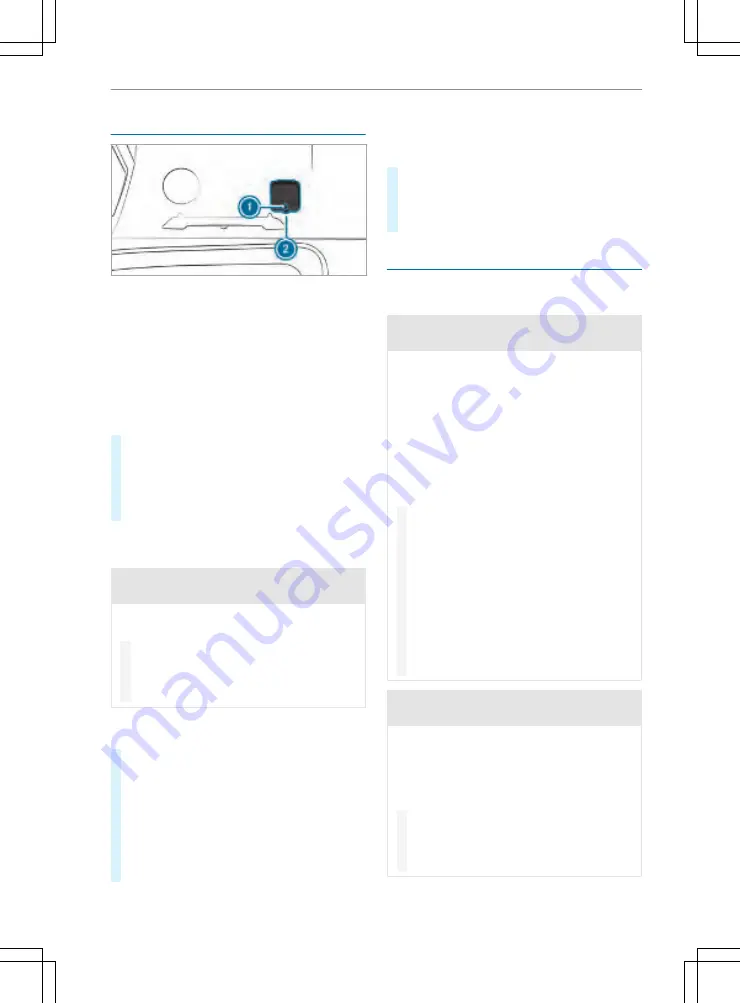
Enabling/disabling the smoke detector
The smoke detector is located above the front
passenger door or on the ceiling behind the
driver.
The smoke detector will alert you if smoke is
emitted in the cab. The alarm can also be trig‐
gered by particles such as those found in ciga‐
rette smoke, dust or exhaust fumes.
Switching the alarm off/temporarily disabling
the smoke detector
#
Press button
1
. The smoke detector will be
disabled for approximately 20 minutes and
will then automatically switch on again.
While the smoke detector is disabled, a brief
tone will sound roughly every 40 seconds and
button
1
will flash every ten seconds.
Checking that the smoke detector is working
properly
&
WARNING Risk of fatal injuries if smoke
detector is not operational
If the battery is empty or the smoke detector
is defective, it will not be able to warn you.
#
Check the smoke detector regularly to
ensure that it is working properly.
#
When the battery runs out, replace it
immediately.
Check once a week to ensure that the smoke
detector is working properly.
#
Press and hold button
1
.
If the smoke detector is working properly, the
alarm will sound. When the button is pressed,
the smoke detector will be disabled for
approximately 20 minutes.
If the battery is empty, a brief tone will sound
roughly every 40 seconds. To ensure that the
smoke detector is working properly, replace
the battery as soon as possible.
Replacing the battery
The smoke detector is powered by a 9 V block
battery.
#
Press release catch
2
and remove the
smoke detector from the holder.
#
Replace the battery.
#
Fit the smoke detector back into the holder.
Stowage spaces and stowage compartments
Notes on stowage spaces and stowage com‐
partments
&
WARNING Risk of injury due to objects
being stowed incorrectly
If you inadequately stow objects in the vehi‐
cle interior, they could slip or be tossed
around and thereby strike vehicle occupants.
In addition, cup holders, open stowage
spaces and mobile phone brackets cannot
always restrain the objects they contain in the
event of an accident.
There is a risk of injury, particularly in the
event of sudden braking or a sudden change
in direction.
#
Always stow objects in such a way that
they cannot be tossed about in these or
similar situations.
#
Always make sure that objects do not
project from stowage spaces, luggage
nets or stowage nets.
#
Close the lockable stowage spaces
before starting a journey.
#
Always stow and secure objects that are
heavy, hard, pointed, sharp-edged, frag‐
ile or too large in the boot.
&
WARNING Risk of injury if the maximum
permitted load is exceeded
If you exceed the maximum permitted load in
the stowage compartment or do not lock the
stowage compartment, the flap may not be
able to restrain objects.
Objects could be flung onto the road.
#
Never exceed the maximum permitted
load for the stowage compartment.
#
Always ensure that the stowage com‐
partment is locked before setting off.
98
Driver cockpit
Содержание Actros
Страница 21: ......





































